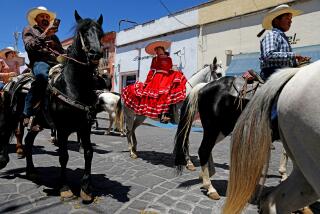Rumble in the Jungle Over Oil
SPANISH LOOKOUT, Belize — This tiny country struck oil in much the same way Jed Clampett stumbled on a gusher in the Ozarks.
A few years ago, a Mennonite farmer dug a shallow well in this bucolic hamlet and up bubbled crude.
“It was just like the Beverly Hillbillies,” said government petroleum inspector Andre Cho, who advertised the incident to woo private investors.
The cast of characters linked to the find is as colorful as anything on television. They include speculators motivated by an Irish self-help guru, Mennonites who have hired an ex-con to extract a better deal for petroleum on their land and a seismic engineer with an unshakable belief that his impoverished nation was brimming with oil.
Belize joined the ranks of the world’s oil exporters in January, when its first shipload of crude hit the market. Production is a mere 3,000 barrels a day, but some Belizeans are dreaming of a payday to rival that of the Clampetts’.
And like the sitcom millionaires, people in this Central American nation of 280,000 are getting a glimpse of the opportunities -- and opportunists -- that accompany $60-a-barrel oil.
Local entrepreneurs are purchasing tanker trucks. Politicians are salivating over a potential windfall. Environmentalists are bracing for the worst.
Across Belize, rumors abound of oilmen in Stetsons rushing to cash in.
“When you see Texans coming down here, you know that something is up,” said Belize City bartender Robert Williams, tapping his blender with authority at a restaurant called the Smoky Mermaid.
Cho said wildcatters have been tantalized by the speed with which Belize Natural Energy -- a small private firm backed mainly by American and Irish investors -- last year found the first significant deposits of oil. In contrast to the heavy sulfur-laden stuff found in neighboring Guatemala and Mexico, Belizean crude is so sweet and light that some local farmers are putting it raw into their tractors.
The strike couldn’t have come at a better time for Belize’s debt-strapped government, which hopes to use oil wealth to reduce taxes and bolster social spending. Normally laid-back Belizeans took to the streets last year to protest a series of price hikes. Hefty taxes on imported gasoline have them paying nearly $5 a gallon at the pump.
Minister of Natural Resources John Briceno calculates that at current prices, the government’s take from even modest oil production of around 60,000 barrels a day would cover the entire national budget.
Belize Natural Energy executives say they won’t know the true size of the find until they do more testing, but one partner told a local newspaper last year that as much as 75 million barrels could be under a 4,000-acre parcel in Spanish Lookout.
“If we could produce even 20,000 barrels a day, you can imagine what we could do with that,” Briceno said. “It could make a huge difference for our little country.”
An Undying Belief
For half a century, oil drillers came to Belize hoping to hit the big one.
Denver billionaire Philip Anschutz spent millions of dollars chasing black gold in this Massachusetts-sized nation located southeast of Mexico’s Yucatan Peninsula. So did Texaco, Chevron and others. Studies hinted at petroleum deposits lurking beneath the jungle floor. But drilling yielded 50 dry holes in as many years.
Thus Belize Natural Energy made history when it struck oil on its first attempt, just 15 miles from the spot where the farmer first found petroleum.
Key to the effort were two of the firm’s partners: Northern Irish-born Susan Morrice, the company’s president and a veteran geologist with two decades of experience in Belize; and the late Mike Usher, an engineer and member of a prominent Belizean family who never gave up on a dream that his nation could be an oil producer.
Usher’s 89-year-old mother, Jane, who still works as general manager of a local credit union, recalls her son bringing rocks to Sunday dinner, insisting they were evidence that Belize was rich in petroleum.
He didn’t live to see his dream fulfilled, dying in 2004 of what his mother said was a liver-related ailment. But she never doubted him.
“Every Sunday it was always the same. The oil thing. The oil thing,” said the mother of 10, known to locals by the respectful title Miss Jane.
With financing from Morrice’s husband, Colorado oil executive Alex Cranberg, and more than 80 Irish investors, the firm used seismic technology to map previously unexplored territory around Spanish Lookout. They found what they believed to be a sizable oil field under Mennonite pastureland.
The company’s roughnecks hit oil three times in as many tries, naming the wells Mike Usher No. 1, Mike Usher No. 2 and Mike Usher No. 3.
Company director Sheila McCaffrey credits a secret weapon for the strikes. All the partners and most of the company’s investors have gone through a course taught by Tony Quinn, an Irish-born “mind technology” consultant. Quinn’s website promotes herbal supplements and a $23,000 two-week seminar in the Bahamas that promises to help participants shed negative thoughts.
Dressed in shorts and a T-shirt on a recent sunny day in Belize, McCaffrey acknowledged that the partners weren’t typical oil executives. Driving a visitor toward the wells at Spanish Lookout, McCaffrey said she could actually feel the energy emanating from the site.
Such talk makes petroleum inspector Cho giggle. But he said he couldn’t argue with the results.
“Hey, they found the oil,” said Cho, a slight, bespectacled 29-year-old who sports a gold stud in one ear. “That’s what counts.”
Uncertain Future
Some Belizeans fear that coaxing the nation’s long-hidden oil to the surface is equivalent to opening Pandora’s box.
Belize boasts lush rain forests, delicate coral reefs, piercing blue skies and what it claims to be the world’s only jaguar preserve.
Environmentalists are in disbelief that a country that has made eco-tourism a pillar of its economy is aggressively courting oil companies.
Because the nation lacks a refinery, pipelines or other basic petroleum infrastructure, the oil must be moved by tanker trucks along narrow, pitted roads to the docks in the southern city of Big Creek for export.
“We simply aren’t prepared,” said Godsman Ellis, president of the Belize Institute of Environmental Law and Policy, who says that spills and other disasters are inevitable.
The nation’s Geology and Petroleum Department is scrambling to add more trained personnel, and Cho’s office in a low-slung cinderblock building with a corrugated roof has become a hubbub of activity.
He said several independent firms that hold drilling rights were moving forward with projects. He has received at least half a dozen new inquiries as well.
Cho said the discovery has given the government greater bargaining power to demand a bigger share of oil revenue in new contracts. Some critics have grumbled that the government gave away the store in its deal with Belize Natural Energy, which pays a 7.5% royalty off the top to the government plus as much as 5% of revenue from production after transportation costs.
The government of neighboring Guatemala, for example, receives royalties of 20% and as much as 70% of the production revenue.
Briceno, the oil minister, said the low royalty and production revenue-sharing figures were necessary to entice oil drillers back to the country. He said that the nation would collect an additional 1% royalty to spend on the environment and social programs and that the contract contained a provision allowing the government to purchase a 10% stake in the firm.
But the Mennonite farmers on whose land the oil was discovered are wary.
Concerns about outsiders meddling in their affairs led the Christian group to flee Mexico 45 years ago for Belize, where they carved space for poultry and dairy farms out of 55,000 acres of jungle around Spanish Lookout. The community of about 1,700 people is virtually independent, funding its own schools, roads and other services.
But the oil find could alter that delicate balance. The federal government, which owns all mineral rights in Belize, has the power to force landowners to accept oil drilling on their property for a small share of the oil revenue.
Early negotiations among the Mennonites, the government and the oil company were cordial, said Erwin Thiessen, chairman of the community. But he said the Mennonites were now pushing for a better deal to compensate for increased traffic, possible environmental and health hazards and a potential disruption to their way of life.
“My biggest concern is how we will deal with this so our community will be protected, so we can continue living on as we have,” he said.
Known as peace-loving and nonconfrontational, the Mennonites have hired an American, Jim Cavanaugh, to advise them. Cavanaugh, now a resident of Belize, served a few months in a federal detention center in Colorado for bankruptcy fraud in 1999. Federal authorities say that when he filed bankruptcy a decade earlier, he falsely stated that he had sold some Trakehner horses valued at $124,000 from his Colorado horse farm for $10,000. Among them: a horse named Belize.
The 75-year-old Cavanaugh now describes himself as a geologist and independent oil and gas consultant with extensive experience in petroleum lease negotiations. He said he was only trying to get a “fair and reasonable” settlement for the Mennonites.
“The profits there are going to be huge,” Cavanaugh said of the oil reserves in Spanish Lookout.
Other Belizeans suspect that they too will be shortchanged. A block away from Belize’s Geology and Petroleum Department in the capital Belmopan, on the crowded campus of United Evergreen Primary School, principal Pamela Neal said she lacked a single computer for her 765 students.
Neal said she would like to believe that the poor Creole, Maya and mestizo youngsters that make up her student body would benefit from any oil riches. But she said the experience of developing nations such as Nigeria, where multinationals and corrupt officials have pocketed most of the wealth, had her fearing the worst.
“We are between the devil and the deep blue sea,” she said.
*
(BEGIN TEXT OF INFOBOX)
Belize at a glance
*
Population: 291,800 (50.2% urban, 49.8% rural)
Capital: Belmopan
Life expectancy: 71 years
Per capita annual income: $3,940
Major ethnic groups: Creole, Garifuna, mestizo, Maya.
Top industries: Tourism, agriculture (citrus, bananas, sugar), shrimp farming
History: Formerly British Honduras, the country became Belize in 1973 and gained independence from Britain in 1981.
*
Sources: Belize Central Statistical Office, World Bank, U.S. State Department, ESRI
More to Read
Sign up for Essential California
The most important California stories and recommendations in your inbox every morning.
You may occasionally receive promotional content from the Los Angeles Times.










